Monday, October 31, 2005
HALOWEEN WEEKEND
 It’s again this time of the year! Our lovely, casual community gathering place, Hirome ichiba market held Halloween weekend events on the 29th and 30th. Of course, that included the big costume dance party Saturday night. Boy we had a blast!
It’s again this time of the year! Our lovely, casual community gathering place, Hirome ichiba market held Halloween weekend events on the 29th and 30th. Of course, that included the big costume dance party Saturday night. Boy we had a blast!Their Halloween events at Hirome ichiba market seem to have grown bigger over the past couple of years, especially the daytime events. Now it is a whole-weekend thing there, instead of a trick-or-treating and costume party on the 31st only as in many other places.
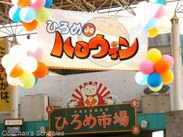 The market was decorated with balloons everywhere and the employees were working in Halloween T-shirts for both Sat and Sun. Even the elder staff at the eateries, who probably had absolutely no idea what Halloween was about and where it came from, were serving food in orange colored T-shirts and with a face painting on. Right outside the entrance of the market, a stage was built so that people could enjoy various shows and performances there both days as well as the kids’ costume contest.
The market was decorated with balloons everywhere and the employees were working in Halloween T-shirts for both Sat and Sun. Even the elder staff at the eateries, who probably had absolutely no idea what Halloween was about and where it came from, were serving food in orange colored T-shirts and with a face painting on. Right outside the entrance of the market, a stage was built so that people could enjoy various shows and performances there both days as well as the kids’ costume contest. I often hear the criticism by both Japanese and non-Japanese people that “The Japanese always adopt foreign customs and make them into money-making strategies without paying any attention to their true meanings or historical backgrounds, etc.,” and I do see their point. I would have fully agreed with such criticism if it were 10 years ago when I was an office worker in Osaka, a way bigger city than Kochi.
I often hear the criticism by both Japanese and non-Japanese people that “The Japanese always adopt foreign customs and make them into money-making strategies without paying any attention to their true meanings or historical backgrounds, etc.,” and I do see their point. I would have fully agreed with such criticism if it were 10 years ago when I was an office worker in Osaka, a way bigger city than Kochi.But now, living in this rural area when the economy is down like this, how can you blame the local folks’ efforts to boost their sales just a little by cooperating to create a fun event together? And isn’t it a blessing after all to be able to see both kids and adults, Japanese and non-Japanese, having fun in this kind of festive atmosphere, with no worries about any danger or crime associated with the event? To me, there are things more important in life than cultural analysis. So in the Halloween weekend in recent years, I give my analytical mind (if I had any) a total break and just pursue fun as much as I can. You know, it’s Kochi here and we are innately fun-loving folks ;)
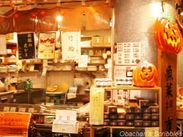 Even the shops selling typically traditional Japanese stuff were decorated with Jack-o-lanterns that weekend. The photo is a shop selling chikuwa and kamaboko (steamed/broiled fish cakes).
Even the shops selling typically traditional Japanese stuff were decorated with Jack-o-lanterns that weekend. The photo is a shop selling chikuwa and kamaboko (steamed/broiled fish cakes).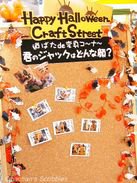

At the counter of what they called “craft street,” kids tried beading, candle making and carving mini-pumpkins.
 Oh, face painting doesn’t hurt, kiddo :)
Oh, face painting doesn’t hurt, kiddo :)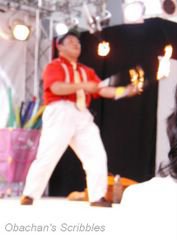 A juggler on stage. (Sorry about blurr pic.) His real job is a computer instructor. He's juggling three fire-lit torches.
A juggler on stage. (Sorry about blurr pic.) His real job is a computer instructor. He's juggling three fire-lit torches.
Musical “Sleepy Hollow” in local dialect by some ALTs (Assistant Language Teachers)

In this musical, Ichabod was killed by ghosts. More scary than the original version??
The main attraction for many adults is the Halloween costume party that starts at around 11:30 pm. This year I was so determined to join the party, but unfortunately I had to work at the izakaya that night until 11:30 pm. The izakaya is only 5 minutes walk from Hirome ichiba so I knew I wouldn’t miss much of the party, but the problem was finding a place to change into the costume. Changing at the izakaya was a big no-no (my colleagues would have teased me for the rest of my life if they had seen me in costume there), and admission fee was more expensive for those without costumes. The solution came from a friend of mine; she let me change in her car in Hirome market’s parking lot. Thanks!
 A samurai and Mr. D (I forgot what he was called.)
A samurai and Mr. D (I forgot what he was called.)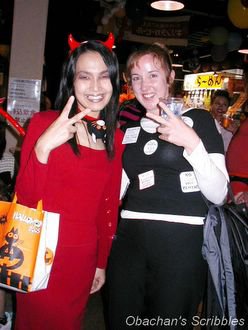 Red devil and devil’s advocate
Red devil and devil’s advocate Dracula and witch -- the musts at any Halloween parties
Dracula and witch -- the musts at any Halloween parties Little mermaid, flower person and…???
Little mermaid, flower person and…??? Award winning, captain … something. I don't remember what he was called. I just called him “captain octopus” for an obvious reason.
Award winning, captain … something. I don't remember what he was called. I just called him “captain octopus” for an obvious reason.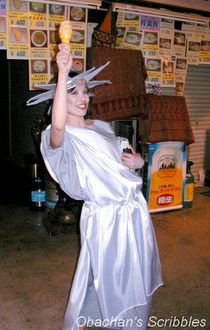 Of course we know that the statue of liberty in NY is holding up a soft serve ice cream cone
Of course we know that the statue of liberty in NY is holding up a soft serve ice cream cone This ultra-man was so shy that he had to wear a mask to be in a picture
This ultra-man was so shy that he had to wear a mask to be in a picture Of course there was Mr. Incredible, too!!
Of course there was Mr. Incredible, too!! And here’s the grand-prize winner, “Mona Lisa.”
And here’s the grand-prize winner, “Mona Lisa.”It was so much fun. And here's my costume. Believe it or not, I won a prize (four coupons worth 2000 yen in total) with this costume! ;)

Monday, October 17, 2005
INTERESTING EXPERIMENT -2
There’s an interesting sake-related project quietly going on in Kochi now. On October 11th, Soyuz, a Russian space capsule, returned to the earth safely. On that spacecraft, some rice and sake yeast from Kochi were aboard, and they were given back to the head of the prefectural industrial technology center(?) at the end of last week. The production of special “Space sake” is said to start in November, using the rice and sake yeast which experienced a space travel with Gregory Olsen.
I really wish they give the sake a most romantic name. I wonder if they would invite ideas from the public.
I really wish they give the sake a most romantic name. I wonder if they would invite ideas from the public.
Sunday, October 16, 2005
TOSA-STYLE CASTNETTING - PART II -
After quick lunch, we went to the river. It was my very first time being on a fishing boat in the river, and to tell you the truth, I felt a little scared when I got on the boat. Compared to the ocean fishing boats I’ve been on, the side of this boat looked very low and I felt so close to the water. There is no doubt that throwing a cast net from the bow of this kind of boat requires a good balance and strength of the lower-body.(Click photos to enlarge. 写真はクリックすると大きくなります。)
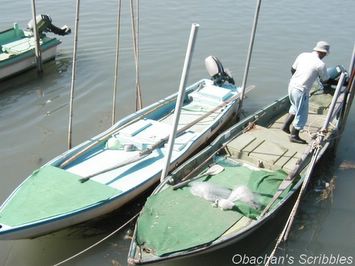

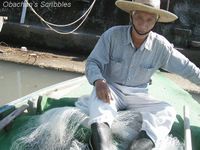
Mr. K was the one to cast net and Mr. YS to control the boat, and their combination was marvelous. Even I, who knew nothing about river fishing, could tell that they were making decisions and controlling the boat taking various things into consideration. Growing up near the rocky beach, I learned, in my childhood, things like what kind of fish/sea shells live in which part of the beach, etc. but there, big rocks and tadpools always helped me remember such information. Here in the river, it's just calm water everywhere with no big rocks, which looked so clueless to me, but they seemed to have no problem in getting the information they needed. Experienced fishermen are amazing.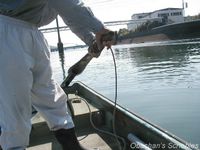
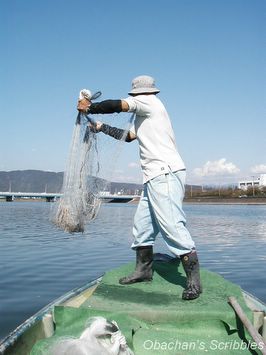
Casting net from boat
Slideshow here. To have a sense of continuum, set the speed to 1 second (fastest).
網を打つ動作をスライドショーで見るにはここをクリック。連続した感じを出すには、スピードを 1 second(左端)にして下さい。
Until I actually saw the net coming out from the river water, I thought cast nets were made in the way that no fish can escape once trapped in the net. However, I noticed that the mesh was larger in the upper part of the net and relatively small fish were able to escape from there easily as the net was being pulled up. That must be the wisdom of the fishermen to prevent overfishing and save fish from extinction.
Unfortunately we didn’t have a catch for about an hour. We tried several places and finally went pretty close to the bay. Mr. K even changed the net he used. Then finally, I heard him saying “We got something!” and …

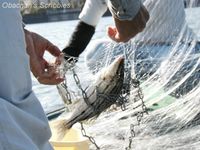
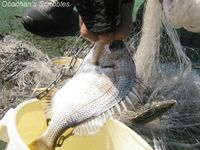
After all, we ended up with 7 to 8 rather small fish only, but I was fully satisfied to see cast net fishing in the river very close. They gave me some fish to take home, and after going back to my apartment, I had a nice fish dinner that night. It was such an exciting day for me. (いただいた魚はこういう料理になりました。)
 According to them, the biggest problem they are facing now is the lack of young members to pass down this traditional asset to. I was told that most of the members are elder people, and there is absolutely no female member in the association. They really want more people to know about and appreciate the unique castnetting culture, which I think is so important.
According to them, the biggest problem they are facing now is the lack of young members to pass down this traditional asset to. I was told that most of the members are elder people, and there is absolutely no female member in the association. They really want more people to know about and appreciate the unique castnetting culture, which I think is so important.
Isn’t it such a shame and big loss if those colorful, hand-made cast nets would completely disappear and names of great masters be just forgotten? Such a loss hurts so much once you get to know the people involved, and saw the joy they feel, efforts they make, and pride they take in the unique culture that they have created and passed down. Especially when that is something you can't find anywhere else! At least that’s the way I feel right now, and I hope I'm not the only one to feel that way.
Information from 高知県投網連盟 Kochi-ken Toami Renmei (a local association of castnetting enthusiasts)
Special thanks to Mrs. K for being a liaison.
-----
The castnetting enthusiasts I met are very interested in how people are enjoying castnetting in different places in and outside Japan. Especially they want to know if "on-land" cast net throwing competition like the ones they have here is held outside Japan. If you felt like sending them a nice message or give them information, please don’t hesitate to comment here. I'll translate and forward it to them.



Mr. K was the one to cast net and Mr. YS to control the boat, and their combination was marvelous. Even I, who knew nothing about river fishing, could tell that they were making decisions and controlling the boat taking various things into consideration. Growing up near the rocky beach, I learned, in my childhood, things like what kind of fish/sea shells live in which part of the beach, etc. but there, big rocks and tadpools always helped me remember such information. Here in the river, it's just calm water everywhere with no big rocks, which looked so clueless to me, but they seemed to have no problem in getting the information they needed. Experienced fishermen are amazing.


Casting net from boat
Slideshow here. To have a sense of continuum, set the speed to 1 second (fastest).
網を打つ動作をスライドショーで見るにはここをクリック。連続した感じを出すには、スピードを 1 second(左端)にして下さい。
Until I actually saw the net coming out from the river water, I thought cast nets were made in the way that no fish can escape once trapped in the net. However, I noticed that the mesh was larger in the upper part of the net and relatively small fish were able to escape from there easily as the net was being pulled up. That must be the wisdom of the fishermen to prevent overfishing and save fish from extinction.
Unfortunately we didn’t have a catch for about an hour. We tried several places and finally went pretty close to the bay. Mr. K even changed the net he used. Then finally, I heard him saying “We got something!” and …



After all, we ended up with 7 to 8 rather small fish only, but I was fully satisfied to see cast net fishing in the river very close. They gave me some fish to take home, and after going back to my apartment, I had a nice fish dinner that night. It was such an exciting day for me. (いただいた魚はこういう料理になりました。)
 According to them, the biggest problem they are facing now is the lack of young members to pass down this traditional asset to. I was told that most of the members are elder people, and there is absolutely no female member in the association. They really want more people to know about and appreciate the unique castnetting culture, which I think is so important.
According to them, the biggest problem they are facing now is the lack of young members to pass down this traditional asset to. I was told that most of the members are elder people, and there is absolutely no female member in the association. They really want more people to know about and appreciate the unique castnetting culture, which I think is so important.Isn’t it such a shame and big loss if those colorful, hand-made cast nets would completely disappear and names of great masters be just forgotten? Such a loss hurts so much once you get to know the people involved, and saw the joy they feel, efforts they make, and pride they take in the unique culture that they have created and passed down. Especially when that is something you can't find anywhere else! At least that’s the way I feel right now, and I hope I'm not the only one to feel that way.
Information from 高知県投網連盟 Kochi-ken Toami Renmei (a local association of castnetting enthusiasts)
Special thanks to Mrs. K for being a liaison.
-----
The castnetting enthusiasts I met are very interested in how people are enjoying castnetting in different places in and outside Japan. Especially they want to know if "on-land" cast net throwing competition like the ones they have here is held outside Japan. If you felt like sending them a nice message or give them information, please don’t hesitate to comment here. I'll translate and forward it to them.
TOSA-STYLE CASTNETTING - PART I -
October 13, 2005
This was the day that I fully enjoyed the privilege of living in this rural prefecture. I had a chance to see the traditional local-style cast net fishing, and went home with some fish given to me as a souvenir!
(Click photos to enlarge. 写真はクリックすると大きくなります。)
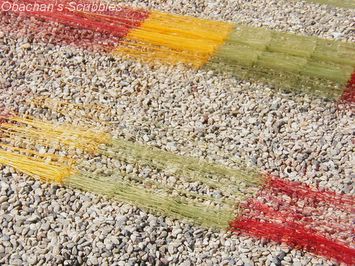
Perhaps cast net fishing is nothing unusual; people in many countries seem to do it for living or for recreation. I even found announcement of “cast net competitions” outside Japan on several websites. However I should say that here in Kochi, they have developed a very unique castnetting culture. Not only they developed a unique throwing style called Tosa-ryu (Tosa style), the enthusiasts in this prefecture practiced on land so hard that they finally turned it into an athletic event, on-land cast net throwing competition called Oka-ami. This “dry” castnetting competition, with the unique, colorful cast nets for “athletic use,” is something you cannot find anywhere else in Japan (or possibly in the whole world?).
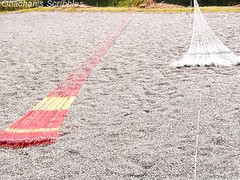 This is how an “athletic” cast net (left) looks compared to a regular cast net commonly used for fishing in the river (right). Athletic versions are bigger, all hand-made and not available at fishing-gear shops, according to Mr. K who invited me to see the demonstration yesterday. What they do is that they buy nylon fishing lines at the store and dye them with the colors they like, and make their original cast nets. Those who are not skillful enough ask more experienced people to make one for them. It is said that two to three weeks are necessary to finish one net and it probably costs around 40,000 to 50, 000 yen (apx. US$350 to US$440) to make one. The leads are usually called “iwa(rock)” but in Kochi they are sometimes called “hiru (leech)” because of their shape.
This is how an “athletic” cast net (left) looks compared to a regular cast net commonly used for fishing in the river (right). Athletic versions are bigger, all hand-made and not available at fishing-gear shops, according to Mr. K who invited me to see the demonstration yesterday. What they do is that they buy nylon fishing lines at the store and dye them with the colors they like, and make their original cast nets. Those who are not skillful enough ask more experienced people to make one for them. It is said that two to three weeks are necessary to finish one net and it probably costs around 40,000 to 50, 000 yen (apx. US$350 to US$440) to make one. The leads are usually called “iwa(rock)” but in Kochi they are sometimes called “hiru (leech)” because of their shape.
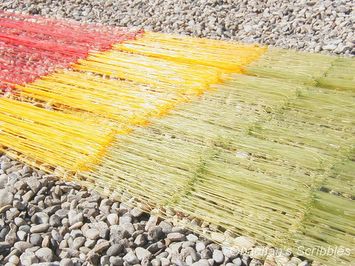
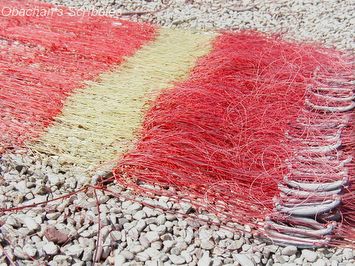

Colorful nets for athletic use
Mr. K, Mr. YM, and Mr. YS kindly demonstrated Tosa-style cast net throwing for me.
 In athletic castnetting, the net must be thrown from a special board which is considered to be the bow of the ship. Mr. K said that here in Kochi, experienced masters used to strictly teach younger members to show respect when getting on the board by taking off shoes and stepping on from rear of the board, not from side or front.
In athletic castnetting, the net must be thrown from a special board which is considered to be the bow of the ship. Mr. K said that here in Kochi, experienced masters used to strictly teach younger members to show respect when getting on the board by taking off shoes and stepping on from rear of the board, not from side or front.

Tosa-style castnetting. Now he’s loaded and ready to throw.
See the throwing motion in a slideshow here. To have a sense of continuum, set the speed to 1 second.
網を打つ動作をスライドショーで見るにはここをクリック。連続した感じを出すには、スピードを 1 second(左端)にして下さい。
It's a little hard to see in the photo, but there are ropes stretched on the ground in a radial pattern to be used as measurement lines. After landing on the ground, the net is measured on certain lines to figure out how far and how wide it spread out, and based on the sum of the measurements, the ranking of the person is decided.
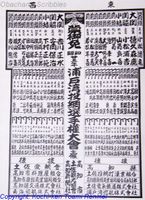 The competition is held 4 times between January and March every year (2 throws per person at one competition), and the annual ranking is decided based on the result of all competitions. This is their official ranking list. If you are familiar with Japanese traditional wrestling, Sumo, you might think that this looks just like Sumo ranking list. Yes, they adopted the ranking system from Sumo wrestling.
The competition is held 4 times between January and March every year (2 throws per person at one competition), and the annual ranking is decided based on the result of all competitions. This is their official ranking list. If you are familiar with Japanese traditional wrestling, Sumo, you might think that this looks just like Sumo ranking list. Yes, they adopted the ranking system from Sumo wrestling.
Copyright:高知県投網連盟 Kochi-ken Toami Renmei
 After each throw, the net must be properly arranged again. It does get tangled sometimes. Mr. YS, very experienced member, always helped others when troubles happened.
After each throw, the net must be properly arranged again. It does get tangled sometimes. Mr. YS, very experienced member, always helped others when troubles happened.
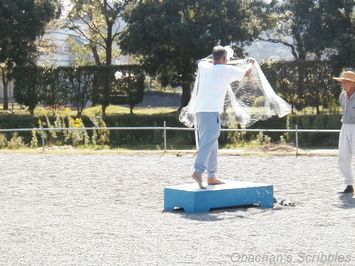
Cast net throwing by Mr. YM
Slideshow here. To have a sense of continuum, set the speed to 1 (fastest).
スライドショーで見るにはここをクリック。連続した感じを出すには、スピードを 1 second(左端)にして下さい。
It was so exhilarating to see the net spreading in the air, making a light friction sound.
The demonstartions finished before noon. I was already delighted to see their performance and to be filled with information on this unique castnetting, but they offered me more. They asked me if I wanted to see them actually net-fishing in the river!! Of course! I was nothing but a shameless middle-aged woman at that moment.
...To be cont’d.
-----
Information from 高知県投網連盟 Kochi-ken Toami Renmei (a local association of castnetting enthusiasts)
* More information on the history of Tosa-style castnetting will be posted here soon. Please wait.
This was the day that I fully enjoyed the privilege of living in this rural prefecture. I had a chance to see the traditional local-style cast net fishing, and went home with some fish given to me as a souvenir!
(Click photos to enlarge. 写真はクリックすると大きくなります。)

Perhaps cast net fishing is nothing unusual; people in many countries seem to do it for living or for recreation. I even found announcement of “cast net competitions” outside Japan on several websites. However I should say that here in Kochi, they have developed a very unique castnetting culture. Not only they developed a unique throwing style called Tosa-ryu (Tosa style), the enthusiasts in this prefecture practiced on land so hard that they finally turned it into an athletic event, on-land cast net throwing competition called Oka-ami. This “dry” castnetting competition, with the unique, colorful cast nets for “athletic use,” is something you cannot find anywhere else in Japan (or possibly in the whole world?).
 This is how an “athletic” cast net (left) looks compared to a regular cast net commonly used for fishing in the river (right). Athletic versions are bigger, all hand-made and not available at fishing-gear shops, according to Mr. K who invited me to see the demonstration yesterday. What they do is that they buy nylon fishing lines at the store and dye them with the colors they like, and make their original cast nets. Those who are not skillful enough ask more experienced people to make one for them. It is said that two to three weeks are necessary to finish one net and it probably costs around 40,000 to 50, 000 yen (apx. US$350 to US$440) to make one. The leads are usually called “iwa(rock)” but in Kochi they are sometimes called “hiru (leech)” because of their shape.
This is how an “athletic” cast net (left) looks compared to a regular cast net commonly used for fishing in the river (right). Athletic versions are bigger, all hand-made and not available at fishing-gear shops, according to Mr. K who invited me to see the demonstration yesterday. What they do is that they buy nylon fishing lines at the store and dye them with the colors they like, and make their original cast nets. Those who are not skillful enough ask more experienced people to make one for them. It is said that two to three weeks are necessary to finish one net and it probably costs around 40,000 to 50, 000 yen (apx. US$350 to US$440) to make one. The leads are usually called “iwa(rock)” but in Kochi they are sometimes called “hiru (leech)” because of their shape.


Colorful nets for athletic use
Mr. K, Mr. YM, and Mr. YS kindly demonstrated Tosa-style cast net throwing for me.
 In athletic castnetting, the net must be thrown from a special board which is considered to be the bow of the ship. Mr. K said that here in Kochi, experienced masters used to strictly teach younger members to show respect when getting on the board by taking off shoes and stepping on from rear of the board, not from side or front.
In athletic castnetting, the net must be thrown from a special board which is considered to be the bow of the ship. Mr. K said that here in Kochi, experienced masters used to strictly teach younger members to show respect when getting on the board by taking off shoes and stepping on from rear of the board, not from side or front.
Tosa-style castnetting. Now he’s loaded and ready to throw.
See the throwing motion in a slideshow here. To have a sense of continuum, set the speed to 1 second.
網を打つ動作をスライドショーで見るにはここをクリック。連続した感じを出すには、スピードを 1 second(左端)にして下さい。
It's a little hard to see in the photo, but there are ropes stretched on the ground in a radial pattern to be used as measurement lines. After landing on the ground, the net is measured on certain lines to figure out how far and how wide it spread out, and based on the sum of the measurements, the ranking of the person is decided.
 The competition is held 4 times between January and March every year (2 throws per person at one competition), and the annual ranking is decided based on the result of all competitions. This is their official ranking list. If you are familiar with Japanese traditional wrestling, Sumo, you might think that this looks just like Sumo ranking list. Yes, they adopted the ranking system from Sumo wrestling.
The competition is held 4 times between January and March every year (2 throws per person at one competition), and the annual ranking is decided based on the result of all competitions. This is their official ranking list. If you are familiar with Japanese traditional wrestling, Sumo, you might think that this looks just like Sumo ranking list. Yes, they adopted the ranking system from Sumo wrestling.Copyright:高知県投網連盟 Kochi-ken Toami Renmei
 After each throw, the net must be properly arranged again. It does get tangled sometimes. Mr. YS, very experienced member, always helped others when troubles happened.
After each throw, the net must be properly arranged again. It does get tangled sometimes. Mr. YS, very experienced member, always helped others when troubles happened.
Cast net throwing by Mr. YM
Slideshow here. To have a sense of continuum, set the speed to 1 (fastest).
スライドショーで見るにはここをクリック。連続した感じを出すには、スピードを 1 second(左端)にして下さい。
It was so exhilarating to see the net spreading in the air, making a light friction sound.
The demonstartions finished before noon. I was already delighted to see their performance and to be filled with information on this unique castnetting, but they offered me more. They asked me if I wanted to see them actually net-fishing in the river!! Of course! I was nothing but a shameless middle-aged woman at that moment.
...To be cont’d.
-----
Information from 高知県投網連盟 Kochi-ken Toami Renmei (a local association of castnetting enthusiasts)
* More information on the history of Tosa-style castnetting will be posted here soon. Please wait.
Tuesday, October 11, 2005
SMELL THE BAMBOO, KIDS...
Last Sunday, on my way back from the market, I saw an event taking place in the central park. I stopped by and walked around for a short while, taking a look at several booths. It looked like an event held by forest-industry related associations, aiming at having visitors familiarize with things related to forestry – such as woodwork, crafts, plants, ecological issues, etc.

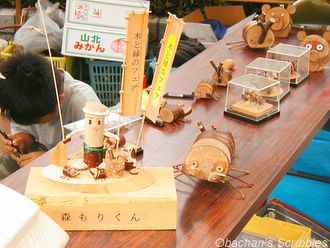

Special emphasis was on several workshops to teach kids how to make and play with traditional toys made from woods.
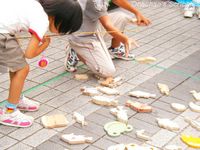
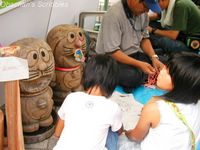
The biggest workshop was taketombo (bamboo dragonfly) making workshop. Kids were making their original taketombo with the help of 3 or 4 adults, and playing with them.
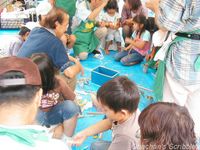

When I was a kid, my parents taught me how to sharpen pencils with a knife, but no one taught me how to make a bamboo dragonfly. Many of these kids must be video-game experts at home, AND now they know how to make traditional handmade toys, too. Lucky them. Isn't that nice to be able to do both?
I really want them to remember the feel and smell of bamboo that they experienced as they made the toys today.



Special emphasis was on several workshops to teach kids how to make and play with traditional toys made from woods.


The biggest workshop was taketombo (bamboo dragonfly) making workshop. Kids were making their original taketombo with the help of 3 or 4 adults, and playing with them.


When I was a kid, my parents taught me how to sharpen pencils with a knife, but no one taught me how to make a bamboo dragonfly. Many of these kids must be video-game experts at home, AND now they know how to make traditional handmade toys, too. Lucky them. Isn't that nice to be able to do both?
I really want them to remember the feel and smell of bamboo that they experienced as they made the toys today.
Thursday, October 06, 2005
SURPRISE!
When I was strolling around in a nearby supermarket yesterday evening, something extraordinary happened. The power went down all the sudden!
Have you ever been in a supermarket when the power was down? It was my very first time, and it really felt strange. Because of the emergency lights, it was not completely dark and we were still able to see our way around. The store manager told us that the whole neighborhood was affected by the power outage, and asked us to wait. All the cashers were at one cash register, trying to figure out something. I assumed that it had some kind of backup system so that all the sales on that day won’t be messed up. Maybe there were some customers who came to buy something real quick and wanted to hurry back. Too bad… Well, that’s life.
Having nothing to do, I just wandered around in the isles, not looking for anything in particular. I thought I might be able to just go home with my groceries without paying, but perhaps the automatic door wouldn’t have opened.
The power came back in about 5 minutes or so and made everyone happy. Thank goodness I didn’t have to stay there for hours. The cause of the power outage was unknown.
Have you ever been in a supermarket when the power was down? It was my very first time, and it really felt strange. Because of the emergency lights, it was not completely dark and we were still able to see our way around. The store manager told us that the whole neighborhood was affected by the power outage, and asked us to wait. All the cashers were at one cash register, trying to figure out something. I assumed that it had some kind of backup system so that all the sales on that day won’t be messed up. Maybe there were some customers who came to buy something real quick and wanted to hurry back. Too bad… Well, that’s life.
Having nothing to do, I just wandered around in the isles, not looking for anything in particular. I thought I might be able to just go home with my groceries without paying, but perhaps the automatic door wouldn’t have opened.
The power came back in about 5 minutes or so and made everyone happy. Thank goodness I didn’t have to stay there for hours. The cause of the power outage was unknown.


